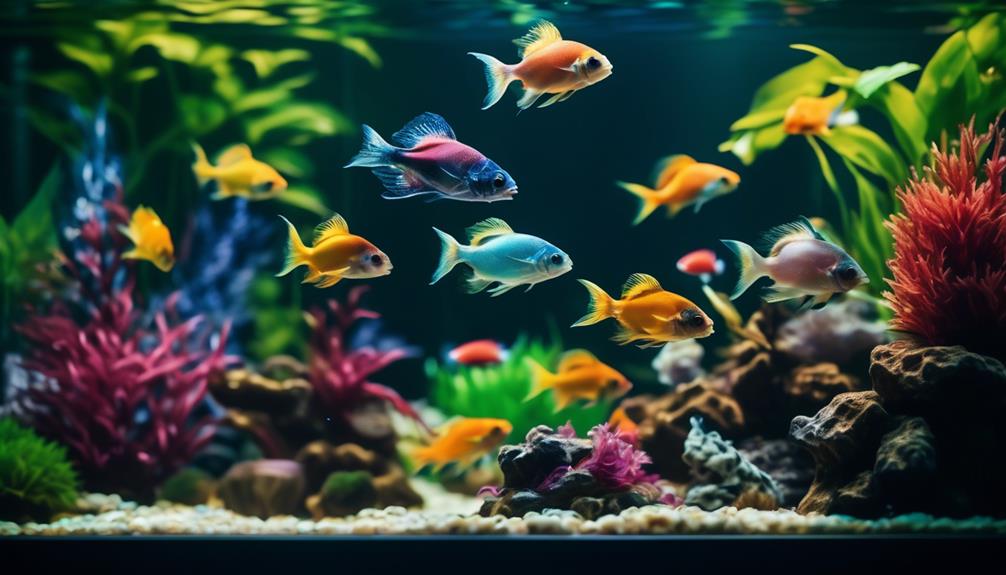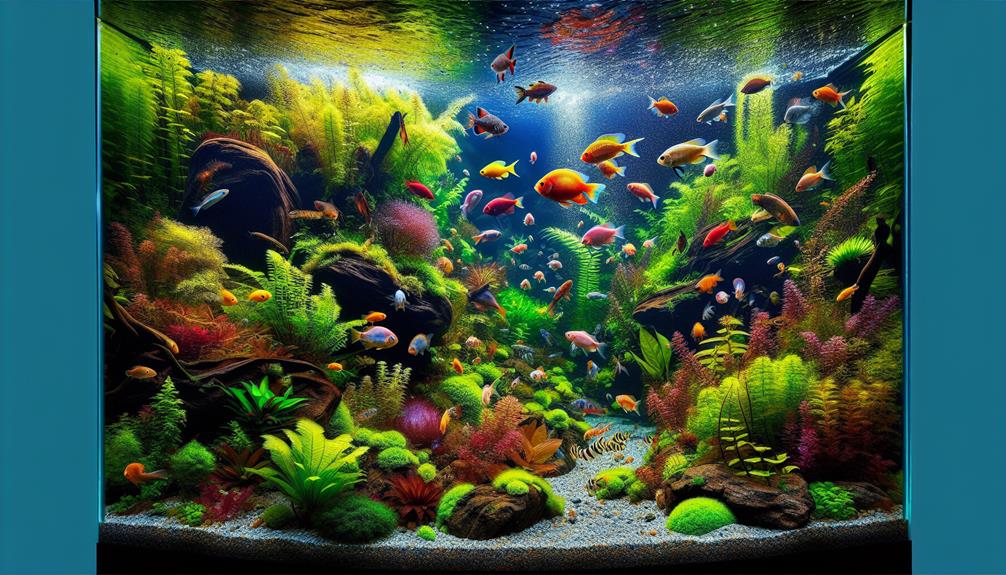When it comes to creating a thriving and aesthetically pleasing planted aquarium, choosing the ideal fish is a crucial step. The right combination of fish can not only bring life and movement to your underwater world but also play a vital role in maintaining the balance of your aquatic ecosystem.
In this article, we will delve into the fascinating world of fish species that are well-suited for planted aquariums. From their unique characteristics to their compatibility considerations, we will explore the secrets behind selecting the perfect fish for your aquatic haven.
So, whether you are a seasoned aquarium enthusiast or just starting out, join us as we unravel the mysteries and unveil the beauty of the ideal fish for your planted aquarium.
Key Takeaways
- Choosing fish for a planted aquarium requires considering their compatibility with other species and water parameter preferences.
- Some suitable fish for planted aquariums include the Elephant Nose Fish, Rummy-Nose Tetra, Siamese Algae Eater, and Congo Tetra.
- Planted aquariums provide numerous benefits such as creating a natural and aesthetically pleasing environment, providing hiding places for fish, and balancing the ecosystem.
- Lighting requirements and maintenance are important factors for the success of planted aquariums, including choosing appropriate intensity and spectrum, trimming and pruning plants, and preventing excessive algae growth.
Key Characteristics of Ideal Fish
When selecting fish for a planted aquarium, it is important to consider their key characteristics to ensure compatibility with the aquatic environment and overall success of the tank.
Fish behavior and suitable tank mates are crucial factors to consider. Understanding the behavior of the fish species you choose is essential for creating a harmonious community. Some fish are territorial and may not tolerate other species, while others thrive in groups and need suitable tank mates to feel secure.
It is important to select fish that have similar needs and temperaments to prevent aggression and stress. By carefully considering fish behavior and choosing suitable tank mates, you can create a balanced and thriving ecosystem in your planted aquarium.
Compatibility Considerations
Compatibility considerations play a crucial role in selecting fish for a planted aquarium, ensuring the establishment of a harmonious and thriving aquatic community. When mixing different species, it is important to consider their compatibility in terms of size, behavior, and water parameter preferences. A visual representation of these considerations can be seen in the table below:
| Compatibility Considerations | Size | Behavior | Water Parameter Preferences |
|---|---|---|---|
| Similar-sized species | Fish of similar sizes are less likely to compete for resources and can coexist peacefully. | Peaceful community fish are compatible with each other, while aggressive or territorial species may not be suitable for a planted aquarium. | Some fish prefer specific water parameters, such as pH, temperature, and hardness. It is important to choose species that have similar preferences to maintain optimal water quality. |
In addition to considering compatibility, maintaining water quality is of utmost importance. Regular monitoring of pH levels, control of ammonia and nitrite levels, and appropriate temperature maintenance are essential. Providing suitable water hardness and alkalinity is necessary for the well-being of both fish and plants. By considering these factors, aquarists can create a thriving and balanced ecosystem in their planted aquarium.
Subscription Benefits

Considering the importance of staying updated with valuable information and accessing a curated collection of live plants, subscribing to our aquarium blog offers numerous benefits for both novice and experienced aquarists.
By subscribing, you will receive weekly articles directly in your inbox, ensuring that you stay updated with the latest aquarium information.
Our blog provides easy access to valuable content, making it a convenient resource for aquarists looking to enhance their knowledge and skills.
Moreover, subscribing to our blog allows you to gain insights and tips for creating a balanced ecosystem in your planted aquarium. Our articles cover topics such as water parameters, lighting requirements, and maintenance tips, helping you provide the optimal conditions for your fish and plants.
Don't miss out on the benefits of subscribing to our aquarium blog.
Recent Blog Posts
One of the latest blog posts highlights the top 5 aquarium fish that thrive in soft water conditions. Soft water, characterized by low mineral content, is preferred by certain fish species due to their specific physiological requirements. These fish include the Elephant Nose Fish, Rummy-Nose Tetra, Siamese Algae Eater, Congo Tetra, and Leopard Bush Fish.
Soft water conditions are essential for their overall health and well-being.
In addition to discussing the ideal fish for soft water conditions, the blog also provides valuable information on how to choose the right plants for your aquarium. Selecting suitable plants is crucial for creating a natural and aesthetically pleasing environment, as well as providing hiding places for fish.
Furthermore, the blog emphasizes the importance of water testing in a planted aquarium. Regular water testing helps maintain stable pH levels, control ammonia and nitrite levels, monitor temperature fluctuations, and ensure optimal water quality for both fish and plants.
Featured Products

The selection of featured products for planted aquariums offers a range of essential items to enhance the overall experience and maintain a thriving aquatic ecosystem.
When it comes to live plants suitable for planted aquariums, options such as Anubias, Java Fern, Amazon Sword, Cryptocoryne, and Vallisneria are highly recommended. These plants not only add beauty to the aquarium but also provide hiding places for fish, oxygenate the water, absorb nitrates, and reduce algae growth, creating a balanced ecosystem.
However, it is crucial to maintain optimal water parameters to ensure the health of both the fish and plants. This involves maintaining stable pH levels, controlling ammonia and nitrite levels, monitoring temperature fluctuations, and providing suitable hardness and alkalinity.
Frequently Asked Questions
What Are the Best Fish for a Beginner's Planted Aquarium?
When considering fish for a beginner's planted aquarium, it is important to choose species that are compatible with each other and the plants. Maintaining a healthy planted aquarium requires careful attention to water parameters, lighting, and regular maintenance.
How Often Should I Feed My Fish in a Planted Aquarium?
In a planted aquarium, it is recommended to feed fish 1-2 times a day, providing them with a balanced diet that meets their nutritional requirements. Pay attention to their appetite and adjust feeding frequency accordingly.
Are There Any Fish That Are Known to Be Aggressive Towards Plants?
Some fish species, such as certain cichlids and goldfish, are known to be aggressive towards plants in a planted aquarium. To deal with aggressive fish, consider choosing more plant-resistant species and providing ample hiding places and enrichment to minimize plant damage.
Can I Keep Shrimp and Fish Together in a Planted Aquarium?
Shrimp and fish can coexist in a planted aquarium, but it's important to consider the behavior of the shrimp and choose fish species that are compatible. A planted aquarium provides benefits such as natural aesthetics and a balanced ecosystem.
How Can I Prevent Algae Growth in My Planted Aquarium?
Preventive measures for algae growth in a planted aquarium include balancing light intensity and duration, monitoring nutrient levels, conducting regular water changes, and maintaining a clean filtration system. Effective algae control strategies involve trimming and pruning plants, preventing excessive nutrient buildup, and introducing algae-eating species like Siamese Algae Eaters or Cherry Shrimp.
Conclusion
In conclusion, selecting the ideal fish for your planted aquarium requires careful consideration and knowledge.
By understanding the specific needs and behaviors of different fish species, as well as the importance of water parameters and suitable plants, you can create a harmonious and thriving underwater world.
Whether it's the mesmerizing schooling behavior of the Rummy-Nose Tetra or the camouflaged elegance of the Leopard Bush Fish, each fish brings its own unique characteristics to enhance the beauty and balance of your aquatic ecosystem.

